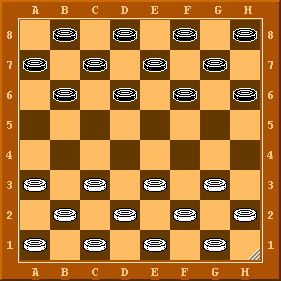
| Next | 4.0 The Checkers Game | Prev |
The regular checkerboard is comprised of 64 squares of contrasting colors, like black and white. The checker pieces may be red and white in color (or any combination of contrasting colors), usually grooved.
The black board squares are numbered either 1 to 32 or using the chess a1 to h8 notation. The diagram below shows the pieces set up for play, with Black occupying squares 1 to 12 (lines 6 to 8 in the chess notation) and White occupying squares 21 to 32 (lines 1 to 3 in the chess notation).
Chess notation:

In many countries (and with boards larger than 8x8) the numerical notation is used instead, all black board squares are numbered from 1 to 32.
Each player (White and Black) controls its own army of pieces. Pieces move only on dark squares which are numbered. The white pieces always move first in opening the game.
The goal in the checkers game is either to capture all of the opponent's pieces or to blockade them. If neither player can accomplish the above, the game is a draw.
Starting with White, the players take turns moving one of their own pieces. A piece means either a man (other name is pawn) - an ordinary single checker or a king which is what a man becomes if it reaches the last rank (see kings). A man may move one square diagonally only forward - that is, toward the opponent - onto an empty square.
Checkers rules state that captures or 'jumps' are mandatory. If a square diagonally in front of a man is occupied by an opponent's piece, and if the square beyond that piece in the same direction is empty, the man may 'jump' over the opponent's piece and land on the empty square. The opponent's piece is captured and removed from the board. Some variants allow only forward direction captures, others allow backward direction captures too.
If in the course of single or multiple jumps the man reaches the last rank, becoming a king, the turn shifts to the opponent. No further 'continuation' jump is possible in some variants of Checkers.
When a single piece reaches the last rank of the board by reason of a move, or as the completion of a 'jump', it becomes a king; and that completes the move, or 'jump'.
A king can move in any direction and 'jump' in any direction one or more pieces, as the limits of the board permit. The king can only jump diagonally over one adjacent piece at a time, in any of the four diagonal directions. Multiple jumps are possible.
| Next | Artificial Intelligence and Perl | Prev |